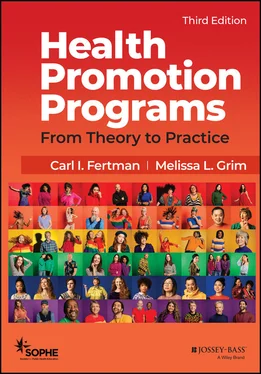(SOPHE) Society for Public Health Education - Health Promotion Programs
Здесь есть возможность читать онлайн «(SOPHE) Society for Public Health Education - Health Promotion Programs» — ознакомительный отрывок электронной книги совершенно бесплатно, а после прочтения отрывка купить полную версию. В некоторых случаях можно слушать аудио, скачать через торрент в формате fb2 и присутствует краткое содержание. Жанр: unrecognised, на английском языке. Описание произведения, (предисловие) а так же отзывы посетителей доступны на портале библиотеки ЛибКат.
- Название:Health Promotion Programs
- Автор:
- Жанр:
- Год:неизвестен
- ISBN:нет данных
- Рейтинг книги:5 / 5. Голосов: 1
-
Избранное:Добавить в избранное
- Отзывы:
-
Ваша оценка:
- 100
- 1
- 2
- 3
- 4
- 5
Health Promotion Programs: краткое содержание, описание и аннотация
Предлагаем к чтению аннотацию, описание, краткое содержание или предисловие (зависит от того, что написал сам автор книги «Health Promotion Programs»). Если вы не нашли необходимую информацию о книге — напишите в комментариях, мы постараемся отыскать её.
Health Promotion Programs: From Theory to Practice
Health Promotion Programs: From Theory to Practice
Health Promotion Programs — читать онлайн ознакомительный отрывок
Ниже представлен текст книги, разбитый по страницам. Система сохранения места последней прочитанной страницы, позволяет с удобством читать онлайн бесплатно книгу «Health Promotion Programs», без необходимости каждый раз заново искать на чём Вы остановились. Поставьте закладку, и сможете в любой момент перейти на страницу, на которой закончили чтение.
Интервал:
Закладка:
Five Key Elements of the Health in All Policies Guide
Promote health, equity, and sustainability . Health in All Policies promotes health, equity, and sustainability through two avenues: (1) incorporating health, equity, and sustainability into specific policies, programs, and processes, and (2) embedding health, equity, and sustainability considerations into government decision-making processes so that healthy public policy becomes the normal way of doing business.
Support intersectoral collaboration . Health in All Policies brings together partners from the many sectors (i.e. intersectoral collaborations) that play a major role in shaping the economic, physical, and social environments in which people live, and therefore have an important role to play in promoting health, equity, and sustainability. A Health in All Policies approach focuses on deep and ongoing collaboration.
Benefit multiple partners . Health in All Policies values co-benefits and win-wins. Health in All Polices initiatives endeavor to simultaneously address the policy and programmatic goals of both public health and other agencies by finding and implementing strategies that benefit multiple partners.
Engage stakeholders . Health in All Policies engages many stakeholders, including community members, policy experts, advocates, the private sector, and funders, to ensure that work is responsive to community needs and to identify policy and systems changes necessary to create meaningful and impactful health improvements.
Create structural or process change . Over time, Health in All Policies work leads to institutionalizing a Health in All Policies approach throughout the whole of government. This involves permanent changes in how agencies relate to each other and how government decisions are made, structures for intersectoral collaboration, and mechanisms to ensure a health lens in decision-making processes.
Finally, public health must share a common vision for progress, a vision based in social justice as a way to achieve health equity. Himmelstein and Woolhandler (2017) proposed what such a vision would be in their 21 st Century Vision for Progress in the United States :
Moving forward to create universal healthcare
Reparations for slavery and Native American genocide
A $15 minimum wage and guaranteed minimum income
Enforcing pay equality and extending reproductive and lesbian, gay, bisexual, and transgender rights
More and better public housing, public education, and public transit
The reversal of mass incarceration and restoration of ex-offenders’ civil rights
Legalization of the undocumented
Expanding clean energy, conservation, and environmental protection
The abolition of nuclear weapons
Achieving these will make it much easier for our country to eliminate health inequity.
Summary
Effective health promotion programs strive to promote health equity and social justice. Health equity means that everyone has a fair and just opportunity to be as healthy as possible. Social justice is the view that everyone deserves equal rights and opportunities—this includes the right to good health. Health status and healthcare vary among individuals and groups of people within the same community. Differences in health status among groups within a community are most often related to economic status, race and ethnicity, gender, education, disability, geographic location , or sexual orientation .
Health promotion programs and health education practitioners address health inequities through interventions that assure everyone’s opportunity to attain their highest level of health. Racism is named and addressed as are root causes of inequity. The Healthy People framework as well as Health in All Policies: A Guide for State and Local Governments (Centers for Disease Control and Prevention. n.d.) are used to address health equity and social justice.
For Practice and Discussion
1 Based on this chapter and on your own experience, how would you define health equity and social justice for a health promotion program? What principles, knowledge, skills, and actions do you want to gain in your work for health equity and social justice?
2 What health equity and social justice issues are relevant to the community in which you live? Reflect on how and why the issues might be of concern for health promotion programs. How do they impact community members’ ability to access safe, affordable programs in a dignified and sustainable way? How do they impact people’s physical, nutritional, cultural, emotional, social, psychological, and spiritual health? What can you do to get involved in your community to address the issues?
3 Start a conversation about health equity within your agency or organization. Health equity is more than one intervention; it’s a lens through which all of your work is viewed. As part of the conversation, how will you achieve fair allocation of community resources and investment in marginalized and under-resourced communities and ensure representation of these groups in decision-making processes?
4 Describe how you would seek partnerships across sectors such as transportation, housing, education, and law enforcement to create conditions that enable all people and communities to attain and sustain good health.
5 What can we as individuals do in our lives to interpret the “isms” (racism, sexism, and ageism) that occur in everyday life? What does it mean for you to be antiracist, anti-sexist, anti-ageist? Focus on actions at the personal level that we encounter with peers and friends in school and community and with our families. Focus on actions with institutional policies and procedures that are barriers to health equity and social justice.
6 Himmelstein and Woolhandler (2017) proposed a health vision for the nation based in social justice as a way to achieve health equity: 21st Century Vision for Progress in the United States. The nine-part vision challenges the status quo. What are the benefits and barriers to achieving their proposed health vision?
| KEY TERMS | |
| Anti-racist | Health equity |
| Health disparities | Health in All Policies |
| Health status | Race |
| Healthcare access | Racism |
| Housing | Root causes |
| Leading Health Indicators | Sexual orientation |
| Poverty | Social justice |
References
1 Anderson, M., Perrin, A., Jiang, J., & Kumar, M. (2019). 10% of Americans don’t use the internet. Who are they? FactTank News in the Numbers, April 22. Pew Research Center. www.pewresearch.org/fact-tank/2019/04/22/some-americans-dont-use-the-internet-who-are-they
2 Arcaya, M. C., Arcaya, A. L., & Subramanian, S. V. (2015). Inequalities in health: Definitions, concepts, and theories. Global Health Action, 8. https://doi.org/10.3402/gha.v8.27106
3 Aro, T., Eklund, K., Eloranta, A. K., Närhi, V., Korhonen, E., & Ahonen, T. (2019). Associations between childhood learning disabilities and adult-age mental health problems, lack of education, and unemployment. Journal of Learning Disabilities January/February, 52(1):71–83. https://doi.org/10.1177/0022219418775118
4 Blas, E., Gilson, L., Kelly, M. P., Labonté, R., Lapitan, J., Muntaner, C., Ostlin, P., Popay, J., Sadana, R., Sen, G., Schrecker, T., & Vaghri, Z. (2008). Addressing social determinants of health inequities: What can the state and civil society do? The Lancet, 372(9650), 1684–1689. https://doi.org/10.1016/S0140-6736(08)61693-1
Читать дальшеИнтервал:
Закладка:
Похожие книги на «Health Promotion Programs»
Представляем Вашему вниманию похожие книги на «Health Promotion Programs» списком для выбора. Мы отобрали схожую по названию и смыслу литературу в надежде предоставить читателям больше вариантов отыскать новые, интересные, ещё непрочитанные произведения.
Обсуждение, отзывы о книге «Health Promotion Programs» и просто собственные мнения читателей. Оставьте ваши комментарии, напишите, что Вы думаете о произведении, его смысле или главных героях. Укажите что конкретно понравилось, а что нет, и почему Вы так считаете.












